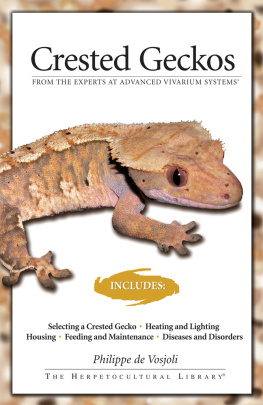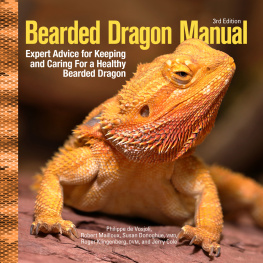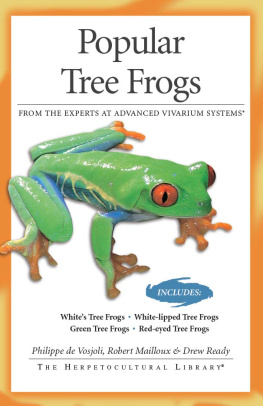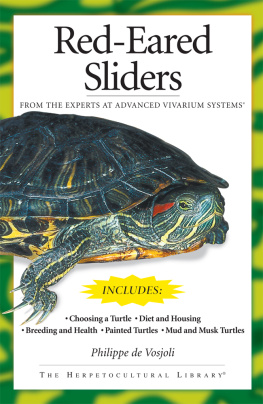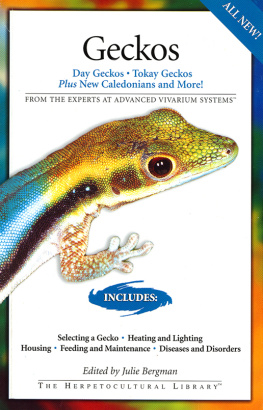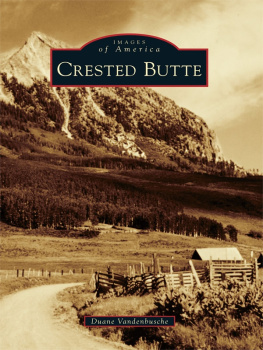Vice President, Chief Content Officer: June Kikuchi
Vice President, Kennel Club Books: Andrew DePrisco
Production Supervisor: Jessica Jaensch
Assistant Production Manager: Tracy Vogtman
I-5 Press: Jennifer Calvert, Amy Deputato,
Lindsay Hanks, Karen Julian, Jarelle S. Stein
Design by Michael Vincent Capozzi
Indexed by Rachel Rice
Cover photography by Philippe de Vosjoli.
All photos by Philippe de Vosjoli except where otherwise indicated.
The additional photographs in this book are courtesy of Anthony Caponetto pp. 7 (top), 8 (top), 2728, 34 (top and middle), 36 (middle), 37 (middle), 40 (bottom), 42 (top), 70 (bottom), 71 (top); Bill Love pp. 7 (middle); David Northcott pp. 11 (bottom), 13 (middle)
Copyright 2005 by Advanced Vivarium Systems, Inc.
All rights reserved. No part of this publication may be reproduced or transmitted in any form or by any means, electronic or mechanical including photocopy, recording or any information and retrieval system, without permission in writing from the publisher, except by reviewer, who may quote brief passages in a review.
LCCN: 96-183295
ISBN-10: 1-882770-80-3
ISBN-13: 978-1-882770-80-9
eISBN-13:978-1-937049-71-3

An Imprint of I-5 Press
A Division of I-5 Publishing, LLC
3 Burroughs
Irvine, CA 92618
We want to hear from you. What books would you like to see in the future? Please feel free to write us with any comments on our AVS books.
Printed in China
14 13 12 11 4 5 6 7 8 9 10
CONTENTS
ACKNOWLEDGMENTS
A s a former biology teacher and an author of more than 25 books on keeping reptiles, I wanted to experiment with a new format that would educate through photographs rather than extensive amounts of text. I am grateful to I-5 Press for allowing me the opportunity to assemble this type of book and for their continuing support of my herp-related writing projects. A tip of the herper hat goes to my good friends Frank Fast, who was my research partner on several field trips to New Caledonia; and Allen Repashy and Bob Mailloux, of Sandfire Dragon Ranch, for their generous help with this endeavor. Frank, Allen, and I were also the coauthors of Rhacodactylus: The Complete Guide, a larger work with more than 350 photos, which reflects our common obsession with this genus of geckos. As always, special thanks are owed to Wild Bill Love and David Northcott for coming through with outstanding photographs, as well as to Anthony Caponetto of ACJ Reptiles for his contribution of hard-to-find shots, such as examples of ontogenetic color change in crested geckos.
CHAPTER 1
GENERAL INFORMATION
B efore the early 1990s, no one could have imagined that the crested gecko (Rhacodactylus ciliatus, a medium-sized gecko in the family Diplodactylidae), then a rare species known from only a few museum specimens, would become one of the most popular and readily available reptiles. Several earlier expeditions to New Caledonia to find this obscure lizard (which was first described in 1866) had proven fruitless, and there were growing rumors that the crested gecko could possibly be extinct. This all changed in 1994 when, following a tropical storm, specimens were sighted on the Isle of Pines (a small island south of Grande Terre, the main island of New Caledonia). Shortly after, field trips by Wilhelm Henkel and his colleagues, and by Frank Fast and the author yielded specimens that were brought into captivity. Surprisingly, these geckos readily bred in vivaria, allowing their offspring to subsequently be distributed to herpetoculturists. Some additional crested geckos were rumored to be smuggled by unscrupulous collectors wanting to capitalize on their rediscovery. The great majority of crested geckos in captivity originated from the Isle of Pines. Crested geckos are also found on Kutomo, next to the Isle of Pines; in several locations on southern Grande Terre; and on the Isle of Belep, north of Grande Terre. In any case, from a relatively small number of animals collected between 1994 and 1996, captive populations of this species have been growing exponentially.
Thousands of crested geckos are now captive-produced annually in the United States to meet the growing demand for this species. Besides being easy to breed, crested geckos have also turned out to be ideal pets. They are relatively small animals that have all of the features that make reptiles such fascinating creatures, including complex scalation and an unusual appearance that makes them seem like they crawled out of a fantasy story. Crested geckos are easy to house, have lower temperature requirements than many other reptiles, and for the most part are naturally tame and harmless. When kept in attractive planted vivaria, they make outstanding display animals. People who work all week and like to take weekend vacations can safely leave crested geckos for two to three days without having to resort to a pet-sitter. Based on records of animals currently in captivity, it appears that the potential longevity of crested geckos is at least 12 years, possibly much longer.
From a specialist standpoint, probably the most interesting feature of crested geckos is that they are polychromatic, naturally producing a wide range of colors and patterns. Combined with a short generation time, this has allowed hobbyists to selectively breed bright red, orange, and yellow morphs that now rank among the most beautiful of all reptiles. As attractive as these morphs may be, we have seen only the tip of the iceberg in terms of the potential this species offers for creating living works of art. In the reptile hobby, the crested gecko is destined to achieve great popularity and become the analog of the koi carp. The establishment of crested geckos in captivity ranks as one of the great accomplishments of herpetoculture.

Crested geckos reach a snout-to-vent length (SVL), the body length excluding the tail, of 4-4.7 inches (10-11.9 cm) and a total length of about 8 inches (20 cm). Adults typically weigh between 1.2 and 2.1 ounces (35 and 60 grams).
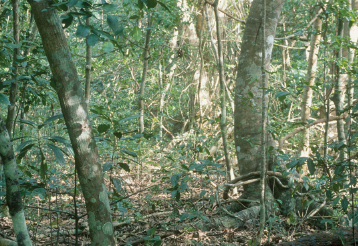
The crested gecko is found only in a primary forest, which is a type of old forest unlogged and undisturbed by human activities. The dense canopy makes it such that there is relatively little vegetation at ground level. The floor of the forest is covered with a layer of leaf litter.
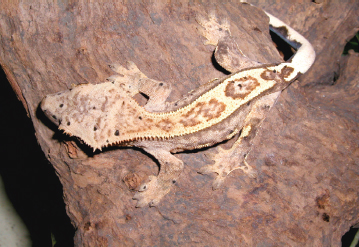
The most obvious distinguishing features of crested geckos are the lateral crests that line the eyes, run along the sides of the back of the head and neck, and run partway down the back.

The crests are variable both in size and the degree to which they extend down the back. This specimen shows average-sized crests.
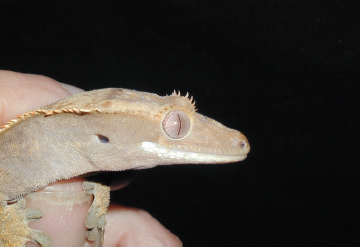
The width of the head and the length of the snout show a range of variation in this species. The snout is relatively long in this individual.
Next page
